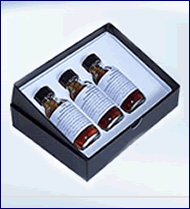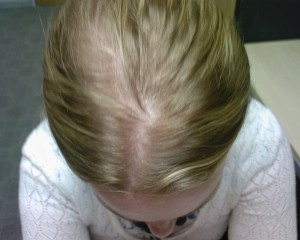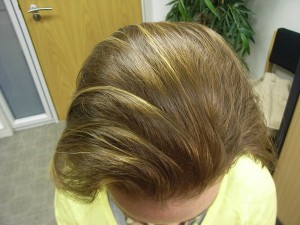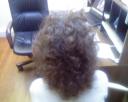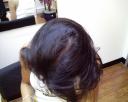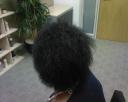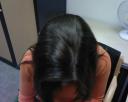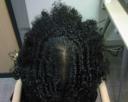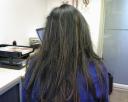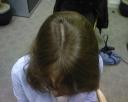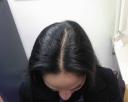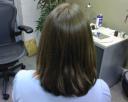28.02.2009
in FEMALE HAIR LOSS, HAIR LOSS SCIENCE
One of the most common causes of hair loss in pre-menopausal women is not hormones, but a nutritional deficiency, with depleted iron stores being the most important factor.

In a study, one hundred and fifty three women who were diagnosed with telogen effluvium from 1995-1998 were examined. Seventy two percent (n=75) of women in the premenopausal group were found to have iron deficiency as the cause of telogen effluvium. Iron deficiency is defined as having a ferritin level of under 40ng/ml or iron percent saturation under 20%. Iron deficiency is the most common cause of telogen effluvium in premenopausal women. Although medications are the most common cause of telogen effluvium in postmenopausal women, iron deficiency should not be ruled out. (Janet L. Roberts Oregon Health Sciences University, Portland, OR, USA)
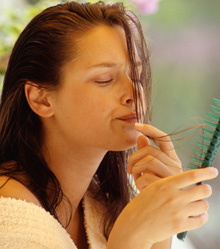
Besides being a possible trigger for telogen effluvium where a lot of hair shedding occurs, iron deficiency could also be the most likely underlying cause when hair loss is subtle; slowly thinning out over many months or even years. This is common among women of childbearing age due to menstruation and pregnancy. Iron is found mainly in the blood, and according to Dr Michael Sharon, author of Nutrients A-Z ‘During one period, a woman will lose around 10-15 mg of iron, while throughout a pregnancy around 600-1000mg will be lost.’

Iron is the mineral that occurs in the greatest amount in the blood. The most important function of Iron in the human body is helping the production of both hemoglobin (the substance that carries oxygen withing red blood cells) and myoglobin. Myoglobin is a form of hemoglobin found in muscles. Iron is also involved in the oxygenation of your body’s red blood cells. It is understood that levels of iron play a significant role in various body functions, however, it is also essential for the normal growth and maintenance of hair. If the amount of energy used up by the body is not replaced by food intake, then other non-essential stores will be used up. Unfortunately, this means the hair cells as they are not a vital part of living.

In order to maintain an adequate balance of iron in the body, the amount excreted must be replaced by the amount ingested in the diet. When the amount of dietary iron absorbed is insufficient, a negative iron imbalance occurs, and consequently iron stores are called upon to make up the deficit.
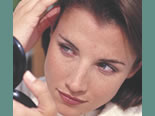
The fall of iron stores normally passes through several stages: lowered iron stores, iron depletion and iron deficiency anemia.
1) Lowered iron stores: This is indicated when the iron stores are reduced but not exhausted. No clinical effects are detected.
2) Iron depletion: Shows up in laboratory tests. Hemoglobin concentration may be well below ‘normal’ for that individual’s reference range. If the patient increases their iron intake, the hemoglobin may respond by increasing.
3) Iron deficiency anemia: No iron is left remaining in the bone marrow. Hemoglobin production falls to the point where concentration is well below the reference range.
It is important to note therefore that iron deficiency (low iron stores, i.e. low ferritin) can occur even if the patient is not clinically anemic and has normal haemoglobin levels
There may be a number of reasons why the amount of iron absorbed is not sufficient. Firstly, only about 10% of ingested iron is absorbed into the blood each day, and this is dependent on the type of food in the diet. Certain foods may inhibit the absorption of iron, such as tanins found in tea and coffee, also bran and egg albumin. Whereas other foods may be enhance the absorption of iron, i.e. vitamin C, alcohol, and flesh foods. In general you can loose iron by: intestinal bleeding, excessive menstrual bleeding, poor digestion, long-term illness, ulcers, and heavy use of anti-acids.
Nutritionist Angel Dowden advises ‘You can maximise your iron absorption by eating a combination of iron-rich foods such as red meat,green, leafy vegetables, shellfish, egg yolk, nuts and cereals with food or drinks that are high in vitamin C for example, a glass of freshly squeezed orange juice.
Avoid tea until at least an hour after eating as it contains tannin, which interferes with iron absorption.
One method of controlling iron deficiency in the body is to stimulate the liver to synthesise ferritin, the protein that stores iron in order to maintain the correct balance. Hair follicles are known to contain ferritin, and when the circulating stores of ferritin decline then these stores are called upon to ensure support for more essential cells, such as bone marrow. The loss of this ferritin from the follicle cells can effect the ability of the hair to grow. This leads to the development of vellus (non pigmented fine hairs) which can be an early indication of deficiency. The presence of vellus hairs is easily mistaken for minaturized hair seen in androgenic alopecia. We should note here that Iron deficiency hair loss could therefore mimic the pattern of androgenic alopecia hair loss.
The Reference Nutritional Intake (RNI) for iron is 14.8mg in women and this should supply you with enough iron for your daily needs. The problem is that not enough women are achieving this value and are therefore becoming deficient. This is, however, easily treated. Vitamin supplements are available which can boost your iron intake on a daily basis, and help reach the normal level within a few months. As soon as the required level is reached hair growth should return to normal. It is preferable that a patient should take iron supplements under a doctor’s supervision, too much iron could also cause hair loss, and even worse, could be toxic.
To diagnose iron deficiency anemia, CBC -complete blood test- is used. Other common lab tests are serum ferritin or serum iron, which examines the proteins involved in the storage and transport of iron through the body, stool occult blood test and TIBC -total iron binding capacity- These tests will determine whether a person has an iron deficiency and the degree of its severity.
No diffuse alopecia (thinning of the hair) should ever be ignored. It can be an early manifestation of several underlying conditions. It is important to realise that an imbalance in iron does not necessarily mean you have anaemia, a serious condition where the ability of the blood to carry oxygen around the body, is reduced. All it means is that your body is not getting enough iron in the diet and is therefore taking it from somewhere else. Another point to remember is that this type of hair loss, caused by deficiency, is also easily treated.
A lot of dermatologists may not agree to the fact that iron deficiency could be a major cause of hair loss, however most of them dont deny that it is an important contributing factor, besides, a lot of hair loss treatments may not work efficiently with low iron stores. Rushton suggests that serum ferritin concentrations of 40 ng/mL or greater are required for maintaining good hair while 70ng/ml is required for regrowth (Rushton DH. Management of hair loss in women. Dermatol Clinic)
References:
1) an article by Angela Mason, School of pharmacy, University of Portsmouth
2) http://www.go-symmetry.com/iron.htm
3) http://my.webmd.com/content/article/1680.50352
4) the institute of trichologists
5) http://www.dermatologist.co.uk/hair.html#medical
6) www.keratin.com
7) An article by By Tony Pearce RN, Consulting Trichologist, National Trichology Services
(and a lot more..)
Do you have Hair Loss Problems, read our Hair Loss Help
![]()











